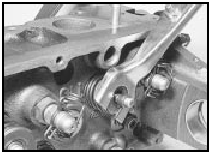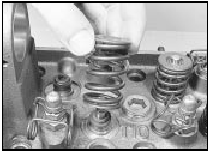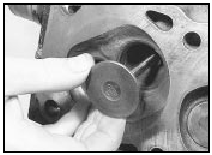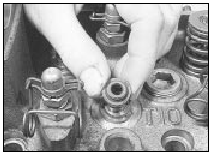Cylinder head - dismantling and reassembly
Note: A valve spring compressor will be required during this procedure. New valve stem oil seals should be used on reassembly.
Dismantling
1 With the cylinder head removed, remove
the camshaft.
2 Using a valve spring compressor, compress one of the valve springs until the split collets can be removed from the groove in the valve stem. Release the compressor and remove the cap and spring, identifying them for location. If the cap is difficult to release, do not continue to tighten the compressor, but gently tap the top of the tool with a hammer.
Always make sure that the compressor is firmly located on the valve head and the cap.
Withdraw the valve (see illustrations).

22.2a Compressing a valve spring

22.2b Removing a valve spring and cap

22.2c Removing a valve
3 Repeat the procedure given in paragraph 2 for the remaining valves, keeping all components identified for location so that they can be refitted in their original positions.
4 Prise the valve stem oil seals from the tops of the valve guides (see illustration).

22.4 Removing a valve stem oil seal
5 Unscrew the cam follower ball-pins from the cylinder head, keeping them identified for location.
Reassembly
6 Commence reassembly by refitting the cam
follower ball-pins to their original locations,
where applicable.
7 Lubricate the valve stems and guides with SAE 80/90 hypoid oil, then insert the valves into their original guides.
8 Wrap a thin layer of adhesive tape over the collet groove of each valve, then smear the new oil seals with a little SAE 80/90 hypoid oil and slide them down the valve stems onto the guides. If necessary use a suitable metal tube to press the oil seals into the guides. Remove the adhesive tape.
9 Working on each valve in turn, fit the valve spring and cap, then compress the spring using the valve spring compressor and fit the split collets to the groove in the valve stem.
Release the compressor and tap the end of the valve stem with a soft-faced mallet to settle the components. If the original components are being refitted, ensure that they are refitted in their original locations.
10 Refit the camshaft.
See also:
Rear suspension angles - general
The rear wheel toe and camber angles are
set in production and do not require checking
under normal service conditions. Of the two,
only the toe setting can be adjusted, the
camber angle being fix ...
Air cleaner element renewal (Every 24 000 miles (40 000 km) or 2 years)
Carburettor models
1 Remove the screws from the top of the air
cleaner cover (see illustration).
38.1 Remove the air cleaner cover screws . . .
2 Where applicable release the spring clips
aroun ...
Loudspeakers - removal and refitting
1 Disconnect the battery earth lead.
Facia panel-mounted speakers
Upper
2 Prise the speaker grille from its four
retaining clips in the facia using a thin-bladed
screwdriver.
3 Remove the four s ...
